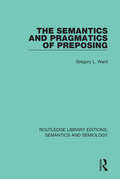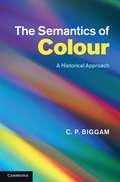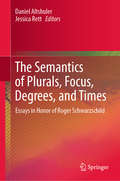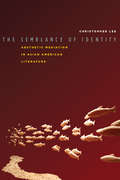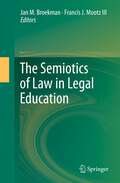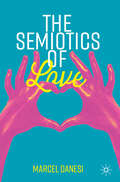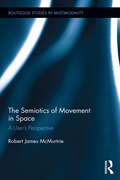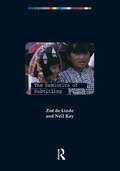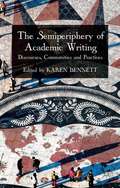- Table View
- List View
The Semantics and Pragmatics of Preposing (Routledge Library Editions: Semantics and Semiology #14)
by Gregory L. WardFirst published in 1988, this book examines the aspects of pragmatic competence involving the class of preposing constructions in English. By limiting the scope of investigation to particular grammatical categories, the author argues previous studies have failed to capture significant pragmatic generalisations. The author asserts what distinguishes one preposing type from another are the semantic and pragmatic properties of the referent of that constituent. After a review of the past literature on preposing, the book goes on to present a pragmatic theory in which two discourse functions of preposing are proposed. It then provides a functional taxonomy of the various preposing types which the theory is designed to account for. One type of preposing, Topicalization, and two of its subtypes, Proposition Affirmation and Ironic Preposing, are discussed in detail in the subsequent chapters before the book concludes with a summary along with directions for future research.
The Semantics of Case (Key Topics in Semantics and Pragmatics)
by Olga KaganThe phenomenon of case has long been a central topic of study in linguistics. While the majority of the literature so far has been on the syntax of case, semantics also has a crucial role to play in how case operates. This book investigates the relationship between semantics and case-marking in the languages of the world, exploring a range of phenomena in which case-assignment is affected by (or affects) meaning. By bringing together data from a wide range of languages, representing different language families, a cross-linguistic picture emerges of the correlation between case and meaning. Different approaches to the phenomena are considered, including both syntactic and semantic analyses, and the question is raised as to whether case can be treated as meaningful, ultimately helping us shed light on the broader connections between grammar and meaning and, moreover, grammar and the human cognition.
The Semantics of Chinese Classifiers and Linguistic Relativity (Routledge Studies in Chinese Linguistics)
by Song JiangThe Semantics of Chinese Classifiers and Linguistic Relativity focuses on the semantic structure of Chinese classifiers under the cognitive linguistics framework, and the implications thereof on linguistic relativity and language acquisition. It examines the semantic correlation between a given classifier and its associated nouns. Nouns in Chinese, which are assigned specific classifiers according to their selected characteristics, reflect the process of human categorization. The concrete categories formed by the relationship between nouns and classifiers may serve to explain the conceptual structure of the Chinese language and certain underlying aspects of culture and human cognition. Song Jiang is Assistant Professor of Chinese for the Department of East Asian Languages and Literatures at university of Hawai‘i at Mānoa.
The Semantics of Colour
by C. P. BiggamHuman societies name and classify colours in various ways. Knowing this, is it possible to retrieve colour systems from the past? This book presents the basic principles of modern colour semantics, including the recognition of basic vocabulary, subsets, specialised terms and the significance of non-colour features. Each point is illustrated by case studies drawn from modern and historical languages from around the world. These include discussions of Icelandic horses, Peruvian guinea-pigs, medieval roses, the colour yellow in Stuart England, and Polynesian children's colour terms. Major techniques used in colour research are presented and discussed, such as the evolutionary sequence, Natural Semantic Metalanguage and Vantage Theory. The book also addresses whether we can understand the colour systems of the past, including prehistory, by combining various semantic techniques currently used in both modern and historical colour research with archaeological and environmental information.
The Semantics of Compounding
by Pius Ten HackenThe question of how to determine the meaning of compounds was prominent in early generative morphology, but lost importance after the late 1970s. In the past decade, it has been revived by the emergence of a number of frameworks that are better suited to studying this question than earlier ones. In this book, three frameworks for studying the semantics of compounding are presented by their initiators: Jackendoff's Parallel Architecture, Lieber's theory of lexical semantics, and Štekauer's onomasiological theory. Common to these presentations is a focus on English noun-noun compounds. In the following chapters, these theories are then applied to different types of compounding (phrasal, A+N, neoclassical) and other languages (French, German, Swedish, Greek). Finally, a comparison highlights how each framework offers particular insight into the meaning of compounds. An exciting new contribution to the field, this book will be of interest to morphologists, semanticists and cognitive linguists.
The Semantics of Determiners (Routledge Library Editions: Linguistics)
by Johan van der AuweraThis book is a collection of linguistic and philosophical papers dealing with the semantic problems of determiners. The language under investigation is mostly English, although a few papers deal with French and German, and, to a lesser extent, with Dutch, Polish, Russian and Hebrew. The majority of the contributions focus on the semantics of the definite and indefinite articles, leading into discussions of anaphoricness, specificness, opacity and transparency, referentiality and attributiveness and genericness. The relation of the determiners to other parts of grammar, in particular relativisation and predication, is also investigated. Some attention is also given to quantifiers. In the spirit of pluralism, there is no single paradigm unifying all the papers, rather, the volume reflects elements of the Extended Standard Theory, Generative Semantics, Montague Grammar, (Gricean) Pragmatics and Speech Act Theory.
The Semantics of Gradability, Vagueness, and Scale Structure: Experimental Perspectives (Language, Cognition, and Mind #4)
by Elena Castroviejo Louise McNally Galit Weidman SassoonThis volume is the first to focus specifically on experimental studies of the semantics of gradability, scale structure and vagueness. It presents support for and challenges to current formal analyses of these phenomena in view of experimentally collected data, highlighting the ways semantic and pragmatic theory can benefit from experimental methodologies. The papers in the volume contribute to an explicit and detailed account of the use, representation, and online processing of gradable and vague expressions using various kinds of controlled speaker judgment tasks, eye tracking, and ERP. The aim is to strengthen the foundations of experimental semantics and promote interaction between linguists, psycholinguists, psychologists, and philosophers who are interested in the semantics of natural language. Using data representing different languages and a variety of nominal and adjectival constructions, including degree modification and comparatives, the contributions address scale-based classifications of gradable predicates, such as the absolute vs. relative distinction; the nature of the standards for applicability of gradable expressions and the ways in which standards are determined; the nature of dimensions and multidimensionality in the meaning of scalar expressions; and the role of embodiment, subjectivity, and sociolinguistic considerations in the use and understanding of gradable expressions.
The Semantics of Metaphor
by Samuel R. LevinOriginally published in 1977. The Semantics of Metaphor presents a theory for the metaphoric construal of deviant sentences. The theory has two aspects. The first relates to metaphor considered as a productive process of language and describes the mechanisms that operate in its semantic interpretation.This part of the theory is presented in chapters III and IV. The second aspect bears on metaphor considered in the context of poetry and develops a conception of metaphoric truth. This part of the theory is presented in chapters VI and VII. The study is semantic in the sense of dealing with both meaning and truth as these properties pertain to metaphor. Of the remaining chapters, the first isolates certain problems of a pragmatic nature from the central semantic concern, chapter II follows with a survey of recent scholarship on the question of semantic deviance, and chapter V compares the theory expounded in chapters III and IV with three other accounts of metaphor.
The Semantics of Opinion: Attitudes, Expression, Free Choice, and Negation (Studies in Linguistics and Philosophy #102)
by Melanie BervoetsThis volume sets out to provide a semantics for the "future-directed opining verbs", a novel class whose members are used to describe subjects' externally attested opinions toward future possibilities. Including verbs like recommend, promise, and permit, the class can be situated within a broader range of opinion verbs, including the well-known propositional attitudes, and key to the investigation here are differences among these groups along the lines of available event types, interaction with the common ground, and restrictions on subjects and objects. Other important semantic topics implicated in the discussion are dispositions, free choice disjunction, and Neg-raising/embedded NPI licensing, and the host of new data associated with the future-directed opining verbs prompts surveys of the expanded scope of these phenomena, and corresponding re-evaluation of existing theories. Collectively, the contributions of this work deepen our understanding of predicates that describe opinion and disposition, and how these interact with fundamental logical operations like negation and disjunction, highlighting the crucial role of contextual factors like relevance for these processes.
The Semantics of Plurals, Focus, Degrees, and Times: Essays in Honor of Roger Schwarzschild
by Daniel Altshuler Jessica RettThis volume is a tribute to Roger Schwarzschild's immense contributions in the formal semantics of nouns, focus, degrees and space, and tense and aspect. Collectively, the papers in the volume reveal parallels across ontological domains, in particular in the context of elements with internal structure, like plural sets, alternative sets, degree intervals, temporal intervals, and vectors. This research suggests that the structure of an entity could inform the semantic behavior of that entity just as much (if not more) than its semantic type or lexical category. And because these structures dictate the formation of semantic alternatives, it can help inform focus semantics and scalar implicature as well. Old questions on plurals, focus and degree expressions get new answers in this collection of papers in honor of Roger Schwarzchild. Roger Schwarzschild is one of the leading scholars in semantics, and the editors have been highly successful in requesting contributions by his teachers, peers and former students. Some papers have circulated in draft form for many years, and find their final home in this edited volume, which well reflects the state of the art in the field. Prof. dr. Henriëtte de Swart, Utrecht University, The Netherlands
The Semantics of the Future (Outstanding Dissertations in Linguistics)
by Bridget CopleyThis book builds a semantics for several kinds of future-referring expressions, including will sentences, be going to sentences, and futurates. While there exists previous work on future-referring expressions, this is the first treatment of such a variety of expressions in a formal semantic framework. Arguments presented herein explicate the meanings of these expressions, and account for similarities and differences among them. Shared is a future-oriented model with a systematic alternation between inertial and bouletic ordering sources that provide a new way of understanding the age-old future Law of the Excluded Middle, evident in all of the future-referring expressions. A difference found among these meanings is the presence or absence of progressive- or generic-like aspect in a position higher than the future modal. These very high aspectual operators affect the temporal argument of the modal's accessibility relation, with detectable effects that can be used to determine scope relations in future conditionals. Copley's analysis thus addresses a number of issues of great interest to formal semanticists, from modal and aspectual semantics, to the mapping of functional elements in the clause, to the logical form of conditionals.
The Semblance of Identity: Aesthetic Mediation in Asian American Literature
by Christopher LeeThe history of Asian American literature reveals the ongoing attempt to work through the fraught relationship between identity politics and literary representation. This relationship is especially evident in literary works which claim that their content represents the socio-historical world. The Semblance of Identityargues that the reframing of the field as a critical, rather than identity-based, project nonetheless continues to rely on the logics of identity. Drawing on the writings of philosopher and literary critic Georg Lukacs, Christopher Lee identifies a persistent composite figure that he calls the "idealized critical subject," which provides coherence to oppositional knowledge projects and political practices. He reframes identity as an aesthetic figure that tries to articulate the subjective conditions for knowledge. Harnessing Theodor Adorno's notion of aesthetic semblance, Lee offers an alternative account of identity as a figure akin to modern artwork. Like art, Lee argues, identity provides access to imagined worlds that in turn wage a critique of ongoing histories and realities of racialization. This book assembles a transnational archive of literary texts by Eileen Chang, Frank Chin, Maxine Hong Kingston, Chang-rae Lee, Michael Ondaatje, and Jose Garcia Villa, revealing the intersections of subjectivity and representation, and drawing our attention to their limits.
The Seminary Student Writes
by Deborah CoreDeborah Core offers practical guidance for beginning seminary students who feel overwhelmed and under-prepared to write the number and quality of papers their courses require. The book begins with reflections on writing as a sacred action, then addresses such practical matters as choosing and researching a topic; outlining, drafting, and polishing a paper; and using the proper format for footnotes and bibliography. Also included are sample papers in MLA and Chicago styles and an overview of grammar and usage.
The Semiotics of Exile in Literature
by Hong ZengFurthering the scholarship on writers and artists as diverse as Lord Byron, Edvard Munch, Sylvia Plath, and Jorge Luis Borges, Zeng probes the semiotics of exile. In artistic traditions the world over, exile exerts a potent and complex mythmaking power - whether it is manifest as a geographical dislocation or as a sense of cultural or psychological alienation.
The Semiotics of Law in Legal Education
by Jan M. Broekman Francis J. Mootz IIIThis book offers educational experiences, including reflections and the resulting essays, from the Roberta Kevelson Seminar on Law and Semiotics held during 2008 - 2011 at Penn State University's Dickinson School of Law. The texts address educational aspects of law that require attention and that also are issues in traditional jurisprudence and legal theory. The book introduces education in legal semiotics as it evolves in a legal curriculum. Specific semiotic concepts, such as "sign", "symbol" or "legal language," demonstrate how a lawyer's professionally important tasks of name-giving and meaning-giving are seldom completely understood by lawyers or laypeople. These concepts require analyses of considerable depth to understand the expressiveness of these legal names and meanings, and to understand how lawyers can "say the law," or urge such a saying correctly and effectively in the context of a natural language that is understandable to all of us. The book brings together the structure of the Seminar, its foundational philosophical problems, the specifics of legal history, and the semiotics of the legal system with specific themes such as gender, family law, and business law.
The Semiotics of Love (Semiotics and Popular Culture)
by Marcel DanesiThe Semiotics of Love brings together work on early symbolism, literary practices, and contemporary communication on the theme of romance and the idea of love to forge an understanding of the semiotic-cultural side of romance. Moving beyond psychological and neuroscientific scholarly analyses of love, Marcel Danesi works to interrogate the cultural constructions of love across societies. This book analyzes romantic love from the general perspective of semiotics—that is, from its more generic interpretive angle, rather than its more technical one. The specific analytical lens used is based on the notion that we convert our feeling structures into sign structures (words, symbols) and sign-based constructions (texts, rituals, etc.), which then allow us to reflect upon something cognitively, rather than just experience it physically and emotionally.
The Semiotics of Movement in Space (Routledge Studies in Multimodality)
by Robert James McMurtrieThe Semiotics of Movement in Space explores how people move through buildings and interact with objects in space. Focusing on visitors to the Museum of Contemporary Art in Sydney, McMurtrie analyses and interprets movement and space relations to highlight new developments and applications of spatial semiotics as he proposes that people’s movement options have the potential to transform the meaning of a particular space. He illustrates people’s interaction with microcamera footage of people’s movement through the museum from a first-person point of view, thereby providing an alternative, complementary perspective on how buildings are actually used. The book offers effective tools for practitioners to analyse people’s actual and potential movement patterns to rethink spatial design options from a semiotic perspective. The applicability of the semiotic principles developed in this book is demonstrated by examining movement options in a restaurant and a café, with the hope that the principles can be developed and applied to other sites of displays such as shopping centres and transportation hubs. This book should appeal to scholars of visual communication, semiotics, multimodal discourse analysis and visitor studies.
The Semiotics of Subtitling
by Neil Kay Zoe De LindeSubtitling serves two purposes: to translate the dialogue of foreign language films for secondary audiences (interlingual) and to transform the soundtrack of television programmes into written captions for deaf and hard-of-hearing viewers (intralingual). While both practices have strong linguistic roots, often being compared to text translation and editing, this book reveals the complex influences arising from the audiovisual environment. Far from being simply a matter of linguistic equivalence, the authors show how the effectiveness of subtitles is crucially dependent upon the hidden semiotic relations between text and image; relations which affect the meaning of the visual-linguistic message and the way in which that message is ultimately received. Focusing primarily on intralingual subtitling, The Semiotics of Subtitling adopts a holistic approach, combining linguistic theory with empirical eye-movement analysis in order to explore the full depth of the medium and the reading behaviour of viewers.
The Semiotics of Theatre and Drama (New Accents)
by Keir ElamThe late twentieth century saw an explosion of interest in semiotics, the science of the signs and processes by which we communicate. In this study, the first of its kind in English, Keir Elam shows how this new 'science' can provide a radical shift in our understanding of theatrical performance, one of our richest and most complex forms of communication. Elam traces the history of semiotic approaches to performance, from 1930s Prague onwards, and presents a model of theatrical communication. In the course of his study, he touches upon the 'logic' of the drama and the analysis of dramatic discourse. This edition also includes a new post-script by the author, looking at the fate of theatre semiotics since the publication of this book, and a fully updated bibliography. Much praised for its accessibility, The Semiotics of Theatre and Drama remains a 'must-read' text for all those interested in the analysis of theatrical performance.
The Semiperiphery of Academic Writing
by Karen BennettWith researchers around the world are under increasing pressure to publish in high-profile international journals, this book explores some of the issues affecting authors on the semiperiphery, who often find themselves torn between conflicting academic cultures and discourses.
The Sensational Proletarian: Leftist Cultures in Colonial Korea
by Kimberly ChungStarving ghosts, anguished farmers, and grieving mothers. Floating heads, gaunt bodies, and masses of bodily fluids. Such are the visceral sensations, exaggerated affects, and suffering subjects that characterized leftist Korean cultural production in the 1920s and 1930s. In popular fiction, print cartoons, reportage, and other emergent forms of mass culture, scenes detailing the spectacular bodily harms endured by figures like migrant workers, tenant farmers, and everyday families proliferated. Yet at the time such representations were criticized as excessively grotesque and insufficiently political by leftist intellectuals, and they have subsequently been overlooked by scholars in favor of socialist realism and its dynamic proletarian heroes. The Sensational Proletarian, by contrast, focuses on these textual and visual representations to tell the story of how new affects and everyday experiences introduced by imperial capitalism and colonial modernity were mediated through the lower-class body. Kimberly Chung traces the emergence of "the sensational proletarian" as a central figure of colonial Korean print culture and reads its varied manifestations as emblematic of Korean efforts not only to grapple with modernity, imperialism, and capitalism, but to do so using the new political ideology and imaginary of Marxism. This book brings to light the centrality of sensational cultures in the development of class politics in Korea, an integral relationship that continues throughout modern and contemporary Korean cultural history.
The Sense and Non-Sense of Revolt: The Powers and Limits of Psychoanalysis (European Perspectives: A Series in Social Thought and Cultural Criticism)
by Julia KristevaLinguist, psychoanalyst, and cultural theorist, Julia Kristeva is one of the most influential and prolific thinkers of our time. Her writings have broken new ground in the study of the self, the mind, and the ways in which we communicate through language. Her work is unique in that it skillfully brings together psychoanalytic theory and clinical practice, literature, linguistics, and philosophy.In her latest book on the powers and limits of psychoanalysis, Kristeva focuses on an intriguing new dilemma. Freud and psychoanalysis taught us that rebellion is what guarantees our independence and our creative abilities. But in our contemporary "entertainment" culture, is rebellion still a viable option? Is it still possible to build and embrace a counterculture? For whom—and against what—and under what forms?Kristeva illustrates the advances and impasses of rebel culture through the experiences of three twentieth-century writers: the existentialist John Paul Sartre, the surrealist Louis Aragon, and the theorist Roland Barthes. For Kristeva the rebellions championed by these figures—especially the political and seemingly dogmatic political commitments of Aragon and Sartre—strike the post-Cold War reader with a mixture of fascination and rejection. These theorists, according to Kristeva, are involved in a revolution against accepted notions of identity—of one's relation to others. Kristeva places their accomplishments in the context of other revolutionary movements in art, literature, and politics. The book also offers an illuminating discussion of Freud's groundbreaking work on rebellion, focusing on the symbolic function of patricide in his Totem and Taboo and discussing his often neglected vision of language, and underscoring its complex connection to the revolutionary drive.
The Sense of Brown (Perverse Modernities: A Series Edited by Jack Halberstam and Lisa Lowe)
by José Esteban MuñozThe Sense of Brown is José Esteban Muñoz's treatise on brownness and being as well as his most direct address to queer Latinx studies. In this book, which he was completing at the time of his death, Muñoz examines the work of playwrights Ricardo Bracho and Nilo Cruz, artists Nao Bustamante, Isaac Julien, and Tania Bruguera, and singer José Feliciano, among others, arguing for a sense of brownness that is not fixed within the racial and national contours of Latinidad. This sense of brown is not about the individualized brown subject; rather, it demonstrates that for brown peoples, being exists within what Muñoz calls the brown commons—a lifeworld, queer ecology, and form of collectivity. In analyzing minoritarian affect, ethnicity as a structure of feeling, and brown feelings as they emerge in, through, and beside art and performance, Muñoz illustrates how the sense of brown serves as the basis for other ways of knowing and being in the world.
The Sense of Semblance: Philosophical Analyses of Holocaust Art
by Henry W. PickfordThe Sense of Semblance is the first book to incorporate contemporary analytic philosophy in interpretations of art and architecture, literature, and film about the Holocaust. The book’s principal aim is to move beyond the familiar debates surrounding postmodernism by demonstrating the usefulness of alternative theories of meaning and understanding from the Anglophone analytic tradition. The book takes as its starting point the claim that Holocaust artworks must fulfill at least two specific yet potentially reciprocally countervailing desiderata: they must meet aesthetic criteria (lest they be, say, merely historical documents) and they must meet historical criteria (they must accurately represent the Holocaust, lest they be merely artworks). I locate this problematic within the tradition of philosophical aesthetics, as a version of the conflict between aesthetic autonomy and aesthetic heteronomy, and claim that Theodor W. Adorno’s “dialectic of aesthetic semblance” describes the normative demand that a successful artwork maintain a dynamic tension between these dual desiderata. While working within a framework inspired by Adorno, the book further claims that certain concepts and lines of reasoning from contemporary philosophy best explicate how individual artworks fulfill these dual desiderata, including the causal theory of names, the philosophy of tacit knowledge, analytic philosophy of quotation, Sartre’s theory of the imaginary, work in the epistemology of testimony, and Walter Benjamin’s theory of dialectical images. Individual chapters provide close readings of lyric poetry by Paul Celan (including a critique of Derridean deconstruction), Holocaust memorials in Berlin, texts by the Austrian quotational artist Heimrad Bäcker, Claude Lanzmann’s film Shoah and Art Spiegelman’s graphic novel Maus. The result is a set of interpretations of Holocaust artworks that, in their precision, specificity and clarity, inaugurate a dialogue between contemporary analytic philosophy and contemporary art.
The Sense of Style: The Thinking Person's Guide To Writing In The 21st Century!
by Steven Pinker"Charming and erudite . . . The wit and insight and clarity he brings . . . is what makes this book such a gem." --Time.com Why is so much writing so bad, and how can we make it better? Is the English language being corrupted by texting and social media? Do the kids today even care about good writing--and why should we care?In this entertaining and eminently practical book, the cognitive scientist, dictionary consultant, and New York Times-bestselling author Steven Pinker rethinks the usage guide for the twenty-first century. Using examples of great and gruesome modern prose while avoiding the scolding tone and Spartan tastes of the classic manuals, he shows how the art of writing can be a form of pleasurable mastery and a fascinating intellectual topic in its own right. The Sense of Style is for writers of all kinds, and for readers who are interested in letters and literature and are curious about the ways in which the sciences of mind can illuminate how language works at its best.From the Trade Paperback edition.
